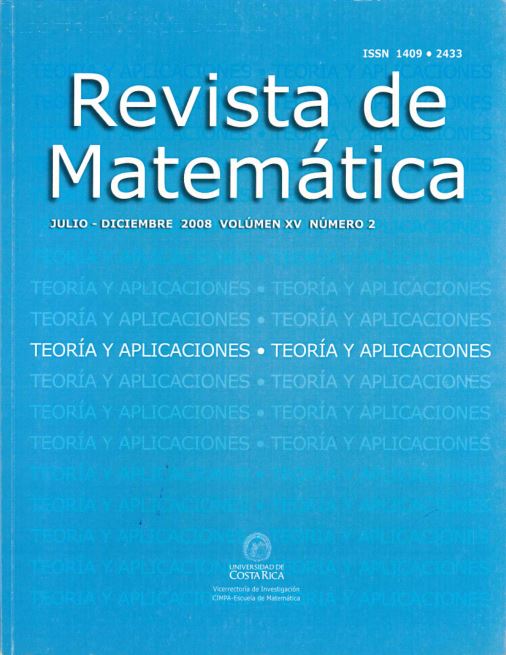Resumen
A partir de los análisis cluster jerárquico de riesgos y de lesiones, se obtiene la secuencia del proceso de conglomeración, basado en este caso en el método de Ward. El interés de dicho proceso de conglomeración, para el caso de las variables riesgo y lesión, componentes del accidente laboral, se centra en que permite interpretar las relaciones entre dichas variables paso a paso, es decir, permite interpretar las afinidades existentes entre dichas variables a escala intragrupal. De esta manera se pueden explicar las relaciones que los diversos clusters van describiendo. Para el caso de los accidentes laborales, esta información interpretativa es de vital importancia al posibilitar asociar un significado a las relaciones entre variables obtenidas matemáticamente, base conceptual de cualquier sistema inteligente.
Citas
Castillo, W.; Trejos, J. (2000) “Nuevos resultados en clasificación bimodal jerárquica y por particiones”, Rev. Inv. Oper. 21(3): 247–259.
Conte Solano, J.C. (2004) Teoría del accidente en poblaciones laborales. Bases matemáticas”. Tesis Doctoral, Universidad de Zaragoza.
Conte Solano, J.C.; García Felipe, A.I.; Domínguez Gracia, A.I.; Rubio García, B. (2004) “Interpretaciones fenomenológicas clásicas del accidente laboral: planteamiento de una orientación alternativa”, Arch. Fac. Méd. Zar. 44(2): 119–124.
Conte Solano, J.C.; Marcos Aragüés, G.; García Felipe, A.I.; Rubio Calvo, E. (2007) “Análisis del problema empírico de identificación del riesgo”, Cuad. Bio. Apl. Inf. 17 (Extra. Bioincertidumbre): 12–25.
Conte, J.C.; Rubio, E. (2005) “Estudio de la relación riesgo-lesión mediante análisis factorial”, Real Acad. Cienc. Zaragoza 60: 65–85.
Conte Solano, J.C.; Rubio Calvo, E.; García Felipe, A.I.; Domínguez Gracia, A.I. (2006) “OMEGA: metodología para la previsión de accidentes en poblaciones laborales. Aplicación a microempresas”, Med. Seg. Trab., LII (203): 27–37. I.S. Carlos III-CSIC. Madrid.
Conte Solano, J.C.; Rubio Calvo, E.; García Felipe, A.I.; Domínguez Gracia, A.I. (2006) “Método OMEGA: aplicación a pequeñas y grandes empresas”, Med. Seg. Trab., LII (203): 39–49. I.S. Carlos III-CSIC. Madrid.
Cuadras, C.M. (1981) Métodos de Análisis Multivariante. Eunibar, Barcelona.
Diday, E.; Lemaire, J.; Pouget, J.; Testu, F. (1982) Eléments d’Analyse des Données. Dunod. Paris.
García Felipe, A.I.; Conte Solano, J.C.; Rubio García, B. (2007) “Propuesta de un proceso automático para planificación en prevención de riesgos laborales”, Cuad. Bio. Apl. Inf. 17 (Extra. Bioincertidumbre): 39–49.
Gaul, W.; Schader, M. (1996) “A new algorithm for two-mode clustering”, in: Bock, H.H. & Polasek, W. (eds.): Data Analysis and Information Systems. Springer, Heidelberg.
González López-Valcárcel, B. (1991) Análisis Multivariante. Aplicación al Ámbito Sanitario. SG-editores. Barcelona.
Joaristi Olariaga, L.; Lizasoaín Hernández, L. (2000) “Análisis de correspondencias”. La Muralla-Hespérides, Col. Cuadernos de Estadística, No. 5. Madrid-Salamanca.
Pyle, D. (1999) Data Preparation for Data Mining. The Morgan Kaufmann Series in Data Management Systems.
Rubio Calvo, E.; Conte Solano, J.C.; García Felipe, A.I.; Torres Portero, M. (2007) “Minería de datos, salud laboral y sistemas inteligentes”, Cuad. Bio. Apl. Inf. 17 (Extra. Bioincertidumbre): 2–11.
Trejos, J.; Castillo, W. (2000) “Simulated annealing optimization for two-mode partitioning”, in: Gaul, W. & Decker, R. (eds.): Classification and Information Processing at the Turn of the Millenium. Springer, Heidelberg
